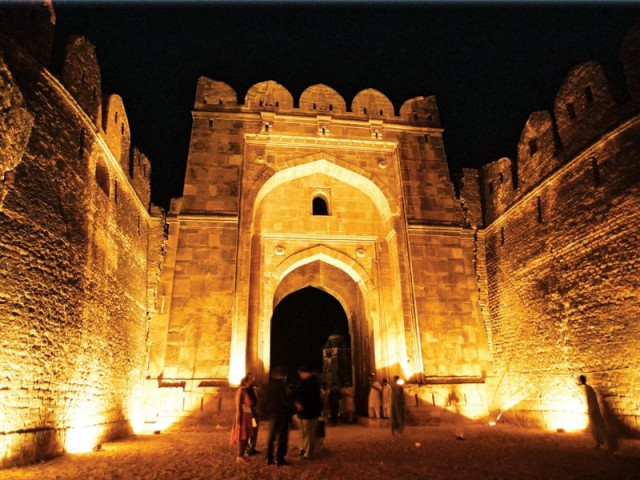Govt, UNESCO to ‘restore’ Rohtas Fort
Project to be completed in two phases will cost over Rs410m

The provincial archeology department in collaboration with the United Nations Educational, Scientific and Cultural Organization – commonly known as Unesco – will execute the ‘master plan’ to preserve the historic Rohtas Fort and fully restore it for tourism.
The project for the ‘world heritage site’ will cost Rs262.354 million rupees in the first phase, while another Rs150 million has been set aside for the second phase with the Punjab government and the UN agency providing the funds. The restoration plan is scheduled to start at the end of August.
The fort is located in the mountain range along the GT Road, a few kilometers from the town of Dina in Jhelum district.
This historic fort was built in 1540 by the Afghan king Sher Shah Suri. It was completed in 8 years. The fort covers an area of 400 acres and is 300 feet above the ground. There are four kilometers of walls with 12 gates. Each door has a different name and a different reason for it. The fort has been hailed as a masterpiece of Arabic, Iranian and Afghan architecture.
Now most of it has been completely destroyed and turned into ruins but it remains an imposing and majestic fort to this day.
Sher Shah Suri built it and Mughal Emperor Akbar captured it around 1630. He made it a defense center while Ranjit Singh, the first rule of the Sikh empire, captured it after the war in 1825. After that, the fort went under the custody of the British regime and it remained that way till the partition of India in 1947.
There are 68 bridges, 184 towers and 8,556 steps in the wide wall of the fort. The wall is three feet wide and 11 feet high at the top. All the platforms of the wall are connected to each other by stairs.
The platforms are three feet wide and were built for archers and gunners to stop the attackers.
There are beautiful mansion residential areas in the center of the Rohtas Fort that are fully enclosed by the fort.
A large beautiful pond was built in the middle of it, in which there used to be different types of fish. Right in the middle of this pond, a beautiful mosque was built in Eidgah style.
This fort was built to protect against Afghan invaders. It was such a defensively safe fort that 40,000 infantry and 30,000 horsemen could stay in the military areas equipped with military equipment.
Eighty-six watch towers were built around it where soldiers were deployed in 24-hour shifts. It had three very deep step wells: one was in the military area while the other two were in residential and work quarters. There were 300 stairs in them. The water-fillers used to fill the water with ease.
At present, only the ruins of its six gates and the large gallows are visible, while the rest is in a state of ruin.
The fort’s exterior walls are missing stones which were carved out by nearby settlers broke for use in the construction of their houses.
The fences here have also been cut down.
The insides of the fort serve as nesting ground for a wide variety of animals. There are wild foliage everywhere. The lack of upkeep, particularly after rain and extremer weather, means the fort maintains barely a sliver of its past beauty.
A deputy director at the archaelogy department said that along with the Unicef-supported project, there were also plans to upgrade restore the historic Nandna Fort, the 1,500-year-old structure on top of the hill in the Salt Range.
Published in The Express Tribune, July 22nd, 2023.



















COMMENTS
Comments are moderated and generally will be posted if they are on-topic and not abusive.
For more information, please see our Comments FAQ